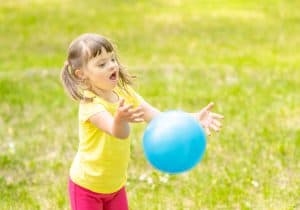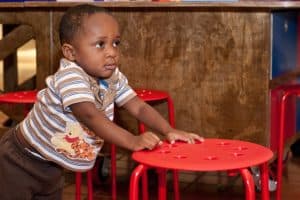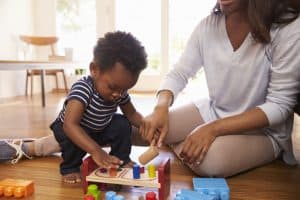Child development – the key to early years practice?
by Annie Richardson on October 11
10 min read:
We often hear a number of ‘givens’ when those working in the sector discuss quality early years practice, such as the importance of play; children’s well-being; inclusive practice; safeguarding and welfare; an enabling environment; and accurate assessment which comes from partnership working with parents/carers. We see these ideas embedded within the Early Years Foundation Stage (EYFS) (DfE, 2021a) and the non-statutory guidance (DfE 2021b; Early Years Coalition, 2021; Grenier, 2020). Within this article I want to pause to consider how a knowledge of children’s development is crucial for early years practitioners and informs these important aspects of quality practice.
The most influential job role that I have had in my 30+ years of working in the early years sector, was supporting children under 5 years with complex special educational needs and disabilities (SEND) and their parents at home, Pre-school and into Reception Class. I had already been an early years practitioner and supervisor in a pack-away setting, and a daycare manager for 7 years, when I joined the SEND support service. I had a Diploma in Pre-School practice which had required an in-depth longitudinal observation study of a child’s development, and with this and my years of practice I really believed I understood children’s development. However, it wasn’t until I started working with babies, toddlers and young children with SEND that I realised how little I had truly noticed and noted in my practice beyond the curriculum frameworks or checklists I had been presented with.
When I joined the SEND support service, they were partly using the ‘Portage Model’ and I undertook Portage training (National Portage Association, 2019). Portage uses a small-steps approach in order to break down long-term goals for children, to provide small achievable targets towards these goals. At the heart of the model is working with families to set realistic goals and provide practical activities which families can incorporate into their daily lives, enabling practice towards, and consolidation of new skills. There were aspects of this model of working at this time, that I later found too prescriptive for my own play-based, child-led pedagogy, but what it taught me was that it is crucial not just to notice what children can do now, but also note what they have done before and what might come next. Each part is to be celebrated because they make the whole child: what they have been; how that has contributed to what they are now; and how this may help to create what comes next. This process partially illustrates Vygotsky’s (1978) idea of the Zone of Proximal development (ZPD): in order to provide for children, we need to understand not only their current development but support them effectively towards their potential development. The best help comes within the ‘Zone’ between what they can do now and what they might achieve next. The adult role is to provide what they need in order to move towards this next remarkable achievement with minimal adult support, whilst being scaffolded to achieve higher levels that you know they will be capable of. The adult will remove that ‘scaffolding’ as the child becomes more able, just like the scaffolding on a house is removed as it becomes more stable. In order to do this effectively practitioners must have a good knowledge of child development, and what foundational skill is needed to develop another.
Portage taught me how important it is to understand significant child development milestones, but also the patterns of children’s development, and not just in one area, but holistically. Too often perhaps we look solely at one area of development in order to assess it, without noticing how intrinsically linked it is to another. For example, we might look at a child starting to cruise around the furniture, but not notice that with this new (higher) view of the world whilst on two feet, there is likely to be an increase in new words as there are different things for the child to see and experience. However, we must be mindful that often this explosion of new words will not occur until children are confident in their new physical skill. The adult role is two-fold: to provide opportunities for the child to cruise, and maybe riskily try a few independent steps and to interact with them about this new exciting view.
Another example is where parents might be desperate for their child to hold a pencil to write their name, but not understand that it isn’t just fine motor skills that children need to develop in order to write. Due to the pattern of physical development from head to toe and moving outwards towards extremities (cephalocaudal and proximodistal) in direction, often practice in gross motor skills is needed in order to work within a child’s current physical development level, rather than force a refined pencil grasp they are not yet ready for. Additionally handwriting requires a number of other skills to be in place such as visual perception, postural control, shoulder stability, co-ordination and balance, and cognitive development (including memory). An enabling environment will provide play opportunities to develop these skills and a parent may need to be supported to understand a long-term plan for their child’s writing skills. Therefore, practitioners require understanding not only of developmental milestones, but the small steps that make up those milestones, in order to support young children effectively.
Many years ago, I attended training by Sally Thomas (2008) in which she stated that we only truly learn about children’s development when we engage in child development training, and observe and note the development of many children. This stuck with me as I understood after my work with children with SEND that actively noting children’s development beyond what was to be assessed, enabled me to see patterns within development and where a previous developmental skill impacted another. E.g Sitting independently and crawling. Alongside this Sally emphasised that children need time to consolidate new skills by being given opportunities to practice them in different ways, rather than being rushed towards the next step. When we work with parents to understand children and their interests, we can provide provocations within the environment at home and in the setting, which enable children to develop what they are ready for. When we truly note children’s development through our observations, we can understand that although each child will follow their own trajectory, there are particular patterns across development which are similar from child to child. We can use this knowledge to inform our planning, assessment, and provision and offer a range of possibilities within the early years environment, that benefit all children.
Previous iterations of the EYFS Non-statutory guidance documents have been criticised for being used as a tick-list. I wonder whether it is a lack of confidence (and time) that encourages this normative maturational approach. No one manageable document will ever capture all aspects of child development and its nuances, and competent practitioners will not rely solely on any one document but use both their knowledge gained through training/literature/research and observations of many children’s development, to inform their judgements. I have too often heard practitioners talk about a child ‘not achieving their goal’ and I always counter this with the fact they are not the child’s goals, they are goals arbitrarily picked by an adult, based on what is deemed essential and valued by those who set educational standards at any one time. A child has their own trajectory and is almost always achieving – we need to focus on what they can do rather than what they cannot (yet) do and recognise their uniqueness. In doing this we can offer what is actually needed by each individual child and the developmental pathway they are on. I suggest that if practitioners are confident in their knowledge of child development, any non-statutory guidance will be an aide-memoire for child development, that scaffolds and inspires practitioners to build and develop a research-based, inclusive, diverse, considered personal pedagogy. This pedagogy can then be used when critically assessing any new iterations of curriculum frameworks decided by future Governments.
The Birth to Five Matters non-statutory document (Early Years Coalition, 2021 p.18) sets out factors which influence children’s development such as interactions, culture and community, and experiences. When considering a child, it is important to recognise that a child does not develop in a vacuum but will have their own life experience, which Bronfenbrenner (1994) described in his Bio-Ecological model. The relationships they have, their positive or negative experiences, the opportunities they are presented with (or not), and the time in which they live, will shape their development, alongside the genes they are born with. Our support needs to take account of these factors. For example, I remember a 4-year-old child who lived in a lower ground floor flat with his mother who had significant mental health problems, and he spent most of his day in his buggy in front of the TV. The child could walk although without confidence. He found stairs very difficult as he had little experience of them, and he was in nappies. The setting he joined listened carefully to the details of his situation. For a month they gave him plenty of practice in walking, running, spinning and rolling on different terrains. They gave him opportunities for carrying heavy buckets and blocks, for using brooms to sweep inside and out, and steps to climb. The potty training came next when his balance, co-ordination and body awareness (including proprioceptive and vestibular senses) had improved. He quickly learned how his bodily functions worked and was soon wearing “big boy pants” despite the health visitor’s initial concerns that he would go to school still in nappies. The practitioner’s informed knowledge of child development and unhurried approach built on what the child could do. They enabled his self-esteem and self-confidence in his abilities to develop through a playful environment, understanding that these gross motor skills were the gateway to his bladder and bowel control. A recognition of the uniqueness of the child, the environment he experienced daily, and a respect for what he bought to the setting enabled them to work on his development from where he was, without seeing him as deficit in skills.
In conclusion, knowledge of child development is crucial, gained through good quality CPD and something to hold tight to in your early years pedagogy, not as a stand-alone skill, but one tool within your toolbox. Much like a power tool, you can bolt other implements on to improve its functionality. For example, recognising the environments and relationships a child experiences, and the impact this has on their development; looking carefully at the map of skills the child has already developed in order to plan for what might be built next; and making a note of the patterns which may help you understand how to use your knowledge to support others in the future. Alongside this it is important to recognise that your power tool will always need an upgrade – by reading, watching and noticing children, further CPD, or being open to new research and approaches. In doing this you can rely on your pedagogy to plan your practice based on your knowledge of the children and families you support, rather than it being dictated solely by the plans of others.
References
Bronfenbrenner, U., Ceci, S. J. (1994) “Nature-nurture reconceptualized in developmental perspective: A bioecological model”. Psychological Review, 101, 568-586. doi:10.1037/0033-295X.101.4.568
DfE (2021a) Early years foundation stage statutory framework, available at: https://www.gov.uk/government/publications/early-years-foundation-stage-framework–2 [Accessed 17/8/21]
DfE (2021b) Development Matters. Non Statutory curriculum guidance for the early years foundation stage, available at: https://assets.publishing.service.gov.uk/government/uploads/system/uploads/attachment_data/file/1007446/6.7534_DfE_Development_Matters_Report_and_illustrations_web__2_.pdf [Accessed 17/8/21]
Early Years Coalition (2021) Birth to 5 Matters, available at: https://www.birthto5matters.org.uk/download-or-buy-a-copy/ [Accessed 17/8/21]
Grenier, J. (2020) Working with the revised Early Years Foundation Stage: Principles into Practice, available at: https://development-matters.org.uk [Accessed 17/8/21]
National Portage Association (2019) What is Portage?, available at: https://www.portage.org.uk/about/what-portage [Accessed 17/8/21]
Thomas, S. (2008) ‘Nurturing Babies and Children Under Four’ (DVD and Resource Pack), Heinemann
Vygotsky, L. S. (1978). Mind in society: The development of higher psychological processes. Cambridge, MA: Harvard University Press.